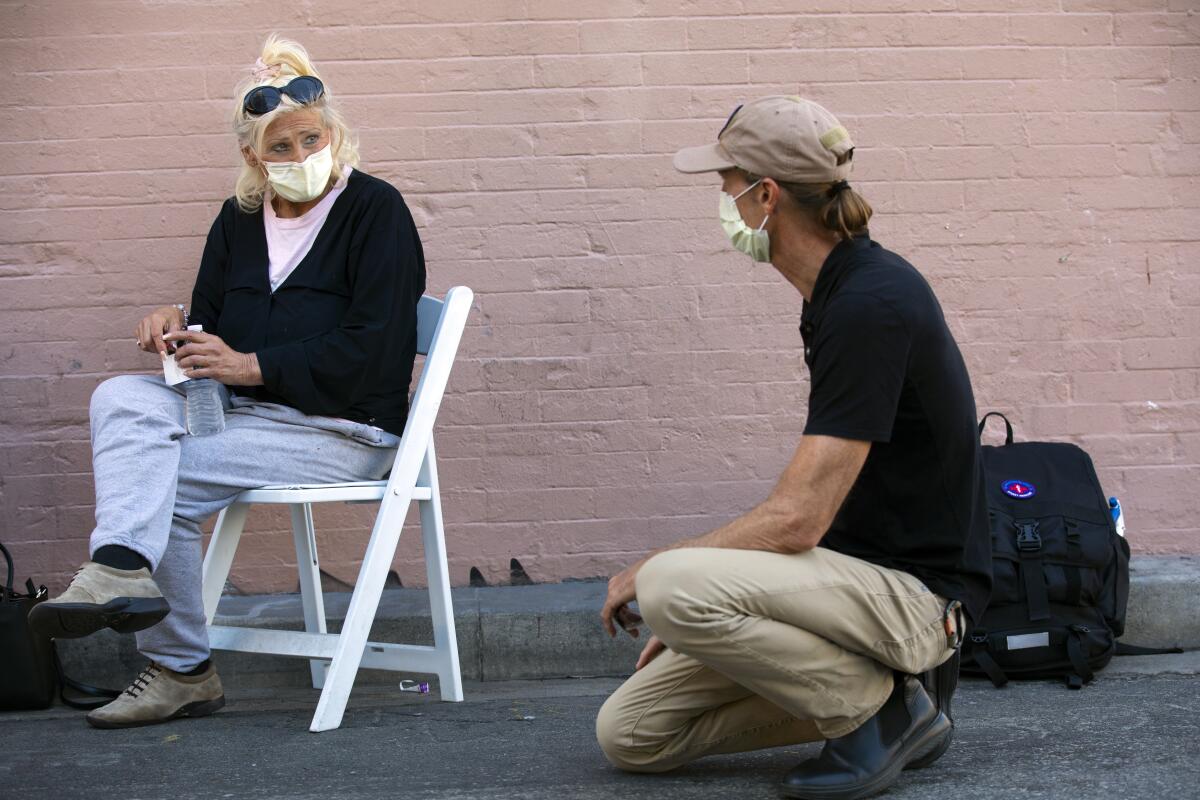How to help a stranger on the street in a mental health crisis

You’re walking down the street, and you encounter someone crying.
Or perhaps the person seems worked up in another way — screaming at the air or rocking back and forth in distress.
A disquieting feeling follows. Do you attempt to say something? Call emergency services? Or, perhaps the likeliest option, avert your eyes, cross the street and keep moving?
It’s not an easy situation to confront. And yet, how to help someone in mental health distress — whether a stranger or a friend — is an essential question in California.
Around 20% of adults in this state have a mental illness, according to the federal Substance Abuse and Mental Health Services Administration, although not every person with a mental illness goes through a crisis, and some people with no previously diagnosed illnesses experience breakdowns. The incidence of mental health problems is considerably higher among unhoused Angelenos — 51% of whom have a mental illness, according to a Times analysis of data from the city’s homeless population count in January 2019.
“If you notice someone who is choking or someone who is having chest pain and bending over … that wouldn’t stop you from asking, ‘Hey, are you having heart pain? Are you having chest pain? Are you having trouble breathing?’” said Dr. Curley L. Bonds, chief medical officer for Los Angeles County’s Department of Mental Health. But many of us don’t react the same way to people in a mental health crisis, Bonds said.
“I think so often, we don’t ask and we don’t activate emergency response because we’re afraid, and we’re trying to be polite,” he continued, “and that person may subtly be trying to reach out.”
Here’s some expert advice about how to recognize when a stranger is in mental distress and how to help without adding harm.
What to look for
“You first want to establish: Is this person having a bad day, or are they in danger of hurting themselves or hurting someone else?” Bonds said. If someone is not doing any self-harm or causing danger to others but is “quietly psychotic,” he said, referring to a person hearing voices or seeming “out of it,” then intervening may not be the right idea “because that could escalate the situation.”
Give yourself a moment to take in the situation. Notice if the person appears agitated, angry, restless or engaging in risky behavior, advised Dawn Brown, national director of the National Alliance on Mental Illness HelpLine Services.
“That person is likely at a point in a mental health crisis where they’re at imminent risk of hurting themselves or someone else,” Brown said.
Keep an eye out for emotional responses that don’t seem to fit the situation, Santa Monica psychotherapist Peter Maduro recommends. For example, someone may be physically hurt but laughing or talking excitedly.
What to consider next
Once you think you’ve determined that the person is in actual distress, Bonds said, your top priority should be safety.
“That is a two-sided coin — there is your safety and the safety of the individual you want to provide assistance to,” Bonds said. “While there may be some strategies for how to intervene, I think you can pretty quickly tell when you make the first entrée whether that person is receptive.”
Notice the environment and tools at hand. Is the person in danger of running into traffic? Experiencing some kind of physical injury that could be affecting the person’s state of mind? Carrying something that could be used as a weapon if the person becomes scared or agitated?
Recognize and respect that you don’t know exactly what’s going on, Maduro said. What happened to the stranger 30 seconds ago — or 30 years ago — is informing that individual in this moment, even if it’s a mystery to you.
“If you don’t know much other than you see someone in an extreme state … honor uncertainty and your humility of not knowing. And if necessary, bear the pain of not being able to do as much as you might like to imagine,” he said. “Live in that natural anxiety. [Don’t] follow an impulse which is really defensive, to pretend you know and maybe create trouble.”
When Brown encounters a person in deep distress, she keeps her cellphone in hand pre-dialed to 911, in case the person could become violent.
“I don’t want anybody to think everybody with mental illness is dangerous or potentially violent,” she said, “but you just don’t know.”
How to make the approach
You’re pretty certain that you’ve identified someone in mental distress, and your initial read of the situation makes you think you and the other person would be safe to interact. You decide to reach out.
Keeping calm is your best strategy, the experts advise.
Approach the person with your heads on the same level, so you’re not towering over the person intimidatingly, Brown said. If you’re interacting with a seated person, sit down nearby.
Getting too close may appear threatening to a person who is already feeling vulnerable, so maintain a physical distance, Bonds recommended. Speak softly.
Don’t stare or hold direct eye contact for long, as it may feel confrontational or threatening, Brown said. Don’t touch them either, she added — something you intend as a gentle gesture may trigger the perception of a threat for them.
You can begin by asking the person simple questions: Do you need help? What does help look like for you? Do you need a doctor? May I make a call for you?
If someone is in distress, Maduro said, there is usually an inherent desire for it to be witnessed, or for their story to be heard.
“Listen to the story and trust it,” Maduro said. “‘That’s a distressing story, how are you feeling? Have you thought about getting help?’”
You can also make observations, Bonds said, such as, “I’ve noticed that you’ve been acting differently,” or, “I noticed that you were yelling recently, and I want you to know that I’m concerned, and I’m here to help.”
“This person may or may not be open to having help,” Bonds said. “You want to invite them to tell you what’s going on. You mainly want to express your support, your concern.”
Save these numbers
Let’s assume the person you’ve approached actually wants your help. Then what? Several organizations have services designed to help someone in mental health distress. You just may need to help the person get connected with one of them.
“Even when I’m out in the street, not in my role as psychiatrist for [the Department of Mental Health], I tend to call the experts,” Bonds said. “If things went south, you just wouldn’t be able to live with yourself, knowing [you] might have ignited something when there are people with training and emergency vehicles that might have had a different outcome.”
Save yourself the trouble of looking up resources in the moment and enter these numbers into your contacts list now:
- The National Suicide Prevention Lifeline can be reached by dialing 988. You can also reach it at 1-800-273-TALK (1-800-273-8255).
The Los Angeles County Department of Mental Health also has a help line available 24 hours a day: (800) 854-7771. The county can provide mental health screening and crisis counseling, a field response or referral to a service provider. There are additional resources for emotional help and veteran support.
The reason to call that 800 number and not the police or 911, Bonds said, is that the county provides an emergency crisis response “that is specific to mental health or psychiatry.” He added, “We know, especially in communities of color, if you call the police and they come out, they come out loaded with weapons.”
- NAMI’s national helpline also connects callers to local support groups, recovery strategies, resource referrals and other information. Call 1-800-950-NAMI (1-800-950-6264) or text “NAMI” to 741-741 to connect with a trained crisis counselor.
If there is an active emergency that needs an immediate response, the experts advise, call 911. “We tell people 911 is the last resort, because you’ll get an immediate police response, and it goes bad fast,” Brown said.
Some jurisdictions have law enforcement personnel specially trained to handle psychiatric emergencies. If you call 911, tell the dispatcher you are observing a presumed mental health crisis and ask for a mental health support response.
“What [law enforcement authorities] have going for them is their capacity ... to hold the situation from getting out of control,” Maduro said. “That may mean involuntarily holding someone. All this stuff can be traumatic. But the bottom line is that’s a backstop.”
If you can, stick around after you call one of these numbers, Maduro continued. “If anything, stay nearby and bear witness,” he said. “Maybe what you can do if the public health response sucks … you can report them.”
Study up
While you’re thinking about how to help your neighbor, you can do some of the best work before you ever encounter someone in distress.
Consider signing up for a course like Mental Health First Aid, Brown recommends. The training usually lasts a few hours and covers how to recognize, understand and respond to crises involving mental illness or substance abuse disorder.
Download and read NAMI’s guide, “Navigating a Mental Health Crisis.”
One of the best tools in your tool kit is empathy, Brown said. If you work on extending empathy to others in your daily life, you’ll be more equipped to do so to a stranger.
A more familiar person in crisis
It’s not always someone on the street who needs help. Sometimes it’s a person you know or have known, such as a co-worker, an old friend whom you’re no longer in close touch with or a distant relative. If you’re concerned about someone who isn’t a stranger, you can use some of the same tactics you’d use with someone on the street, such as approaching calmly and kindly, making observational statements and asking if you can help.
You can start by saying you’ve been thinking about the person lately, Brown said. Maybe relay an example from your own experience of a time when you were down, to provide some common ground.
“You may not be sure it’s a mental illness … you just know that you’re concerned and you’ve seen things that don’t line up or aren’t consistent with their usual behavior,” she said.
As always, ask how you can best help. Maybe the person needs support securing the right resources. Offer to search for therapists in the area or to help figure out the mental health benefits available. If necessary, ask if you can join together on a call to a resource like NAMI or the National Suicide Prevention Lifeline.
“When you’re dealing with depression or anxiety, you don’t have the energy or stamina to go through all these hoops,” Brown said, “or you may not even think you’re worth the effort.”
Having an initial familiarity — even if it’s someone you don’t know well — can help you and the person you’re trying to assist. But don’t be afraid to reach out to someone who isn’t in your community, Bonds said.
“If it’s a Latino child or an African American child and a white coach or white teacher, they may not be as inclined to do something compared to when it’s a family member or church member, someone they know and trust in their community,” Bonds said. “I want to tell everybody, you should reach out across whatever cultural lines there are.”
How to know when to walk away
At a certain point, the interaction must come to an end. That could happen when the person is OK, Bonds said — either in a safe space with access to help or not confronting a mental health challenge in the first place. Or your help may simply be rejected.
“The final outcome is: You want to have some resolution that the person has gotten help or they have adamantly denied it,” Bonds said. “If they don’t want help and they’re not in immediate danger, I think that’s where our role as good Samaritans really ends.”
More to Read
Sign up for Essential California
The most important California stories and recommendations in your inbox every morning.
You may occasionally receive promotional content from the Los Angeles Times.







